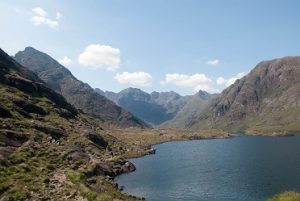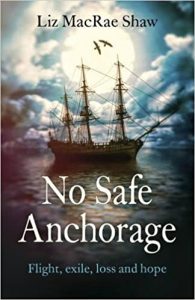How the Isle of Skye has Influenced my Writing
By Liz MacRae Shaw
 I was brought up in the south of England but my mother was born and bred on the Isle of Skye so every summer I spent a month on the island with my grandparents. The wild beauty of Skye made a huge impression on me as did the distinctive music, the lilt of the Gaelic language and the store of tales I heard, especially on Friday evenings when neighbours and relatives came round for a ceilidh.
I was brought up in the south of England but my mother was born and bred on the Isle of Skye so every summer I spent a month on the island with my grandparents. The wild beauty of Skye made a huge impression on me as did the distinctive music, the lilt of the Gaelic language and the store of tales I heard, especially on Friday evenings when neighbours and relatives came round for a ceilidh.
I was intrigued to hear that Màiri Mhòr nan Orain (Great Mary of the Songs), the nineteenth century Skye bard and political campaigner might have been in our family tree. She was born into a crofting family and like many islanders moved to Inverness in search of work.
In middle age she was falsely accused of theft by her employer. She poured her rage and despair into songs about her fellow Highlanders who were being driven from their homes during the Clearances. Through force of character, she overcame the barriers of background, class and gender to become their champion and inspiration. Her life story was the inspiration behind my first book, ‘Love and Music will Endure’. The title comes from a Gaelic proverb which translates as, ‘When the world comes to an end, only love and music will endure.’
From childhood onwards we seek out stories, starting with our own personal one. Every family has nuggets of gold buried in their past and we have a human need to become prospectors and find the shining fragments. I was intrigued to find an unexpected heroine among my ancestors, especially pleasing because women tended to be confined to a domestic role and so were less likely to appear in official records.
Florence Nightingale, ‘The lady with the Lamp’ is famous because of how she transformed the treatment of wounded soldiers during the Crimean War and is said to have carried her lamp to check on her patients during her night rounds. My ancestor, Janet MacKenzie, who lived at the same time is also associated with providing light but in a different context.
 She lived during the 19th century on the small island of Rona, a rocky outcrop that stretches out like a fingertip from the long island of Raasay, off the coast of Skye. Her house was on the shore of An Acarsaid Mòr (Big Harbour). In 1822 water supplies on the island had run low after a prolonged spell of dry weather so Janet’s husband set sail for Skye to replenish the stores.
She lived during the 19th century on the small island of Rona, a rocky outcrop that stretches out like a fingertip from the long island of Raasay, off the coast of Skye. Her house was on the shore of An Acarsaid Mòr (Big Harbour). In 1822 water supplies on the island had run low after a prolonged spell of dry weather so Janet’s husband set sail for Skye to replenish the stores.
It’s not certain how many people were aboard the boat, possibly as many as nine. They included one of Janet’s sons, her brother and a neighbour. On the return journey, they were accompanied by two servant girls who were coming to work in Janet’s house. The events of the voyage are recorded in The Inverness Journal of 22 March, 1822.
The boat set out from the east side of Trotternish, Isle of Skye, in the morning with a strong breeze at S.W. Towards noon it blew stronger but the boat got safely to within a mile of Rona where, being overpowered by the squall, and the people being unable to lower the sail, owing to some failure in the tackle, they were buried among the waves in sight of their friends who anxiously observed the progress from the shore.’
Sadly, drowning at sea was all too common and many women were left as grieving widows but Janet’s response was a unique one. In 1851 she is mentioned in a letter from Captain Otter, the commander of a Royal naval Survey ship, writing to Alan Stevenson, engineer to the Commissioners of the Northern Lighthouses. This is an extract from it.
‘I have taken an interest in a philanthropic widow…her cottage is on the beach and in such a position that a light in one of her windows clears all the rocks at the entrance of the harbour. For ten years she has kept this light burning… much oil is therefore expended. Many boats owe their safety from the storm to the poor widow’s lights….
Captain Otter suggested that the Commissioners pay for the oil but it appears that they gave her a larger lamp instead! In 1857 the Rona lighthouse came into service and Janet’s role as ‘the widow with the lamp’ ended.
 Alan Stevenson was the uncle of Robert Louis Stevenson, the famous writer. He accompanied his father and uncle on trips to Scottish islands where lighthouses were planned. There is no record of him going to Rona but what if he had? The seed of the idea for ‘No Safe Anchorage’ was sown. The main character is Tom Masters, an imaginary officer on Otter’s ship whose adventures take him to Canada.
Alan Stevenson was the uncle of Robert Louis Stevenson, the famous writer. He accompanied his father and uncle on trips to Scottish islands where lighthouses were planned. There is no record of him going to Rona but what if he had? The seed of the idea for ‘No Safe Anchorage’ was sown. The main character is Tom Masters, an imaginary officer on Otter’s ship whose adventures take him to Canada.
My latest book, ‘Had We Never Loved So Blindly’ is due out on 30 April. It was inspired by my uncle, a fisherman who like many Skye men joined the Merchant Navy during the Second World War. It tells the tangled story of his relationship with Felicity, an upper-class English woman who finds a job at Bletchley Park. The title comes from the song, ‘A’e Fond Kiss’ by Robert Burns.
—
Find out more about Liz here: http://lizmacraeshaw.com/
Had We Never Loved So Blindly: In Peril On Land And Sea
 In 1937, fisherman’s son, John Norman’s first encounter of Felicity MacDougall, the daughter of a retired tea planter, is prickly at best. But, a chance meeting during a London air raid leads to a tentative romance, which becomes long distance when John joins the Navy and Felicity takes a job at the famous, secretive Bletchley Park. Their relationship falls prey to the timeless obstacles of insecurities, doubts and misunderstandings.
In 1937, fisherman’s son, John Norman’s first encounter of Felicity MacDougall, the daughter of a retired tea planter, is prickly at best. But, a chance meeting during a London air raid leads to a tentative romance, which becomes long distance when John joins the Navy and Felicity takes a job at the famous, secretive Bletchley Park. Their relationship falls prey to the timeless obstacles of insecurities, doubts and misunderstandings.
Can they overcome the distance between them, and also the war? This love story, forged amid the emotional intensity of WW2, is the beating heart of Liz MacRae Shaw’s new novel. John and Felicity’s relationship has fateful consequences, not only for them, but beyond, into the next generation…
BUY HERE
Category: On Writing



